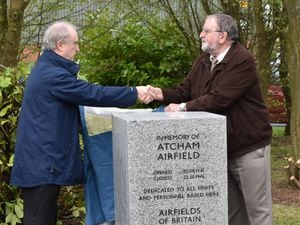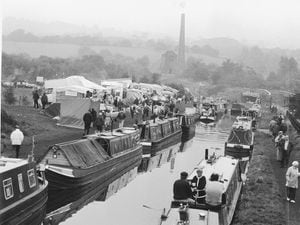Time to celebrate region's industrial architecture, says expert
Sir Simon Jenkins describes the scene from the window of a train carriage from Birmingham, through Wolverhampton, to Shrewsbury.

"There's many old industrial buildings lying in a state of neglect, it's such a waste," he says.
"There's no reason whatsoever for building on the countryside in Shropshire when you have so many buildings which could be brought back into use."
The historian, author, and former editor of The Times is in Ironbridge next month talking about his new book on the architecture of British railway stations. But he also speaks of his sadness at the state of buildings alongside many railway stations too.
"The two greatest eras of British architecture are based around medieval history, and Victorian Britain, which was dominated by industry and factories," he says.
"The West Midlands was at the forefront of that change, and there are so many great examples of industrial architecture around the area."
Sir Simon, who describes himself as 'a proud son of Birmingham', says the many neglected old factories and wharfs along the railway tracks and canals of the West Midlands could have such an exciting future if only people had the imagination – and the cash – to renovate them.
"There's no Victorian building you can't renovate," he says. "It's amazing what you can do with them.
"If you go around London, there are so many of these old buildings that have been brought back into use, and the Gas Street basin is one of the most attractive areas of Birmingham."
While Jenkins, a former chairman of the National Trust, is best known for his books England's Thousand Best Churches and England's Thousand Best Houses, he says industrial architecture should not been seen as a poor relation.
"The great thing about the Midlands is that you still have the wonderful canals, and the Iron Bridge is fantastic," he says.
Getting back to the railways, his book The Rise, Fall and Rise of the British Station looks predominantly at buildings constructed during the Victorian era. Many of these fell into a state of decline during the 20th century, and are now seeing something of a revival.
"In the early days of the railways, competition was so intense, you would have towns that had two or three stations. That was wonderful competition, but is was also very wasteful," he says.
While the days are long gone when the old rail companies would compete for passengers by constructing ever more palatial buildings, Jenkins believes there is still something decidedly romantic about railway stations.
"Stations are places of purpose," he says.
"They are for arriving and departing, joy and sorrow, greetings and goodbyes. They are places where people cry.
"Britons are so rarely permitted to show emotion in public but they do on a station platform."
And it is probably true that Brief Encounter would not have worked in a bus station.
While the route from Birmingham to Shrewsbury is scarred by the decline of Britain's once-proud industry, Jenkins believes the station at the end of the journey makes it all worthwhile.
"Shrewsbury station is magnificent, but it needs a bit of attention," he says.
Like many of Britain's grand stations, the imposing red-brick building, with mock-Tudor features to reflect the styling of the nearby Shrewsbury School, fell victim to unsympathetic alterations and a general lack of maintenance during the postwar years. It has seen some restoration work – new toilets, refurbished waiting rooms, and renovation to the canopies over the platforms, but Jenkins believes it needs somebody with a bit of vision to create a building fit for the 21st century.
"It stands out as as a gem in the area, but it needs a really good architect to come up with some bright ideas," he says. "There should be a wonderful walkway out to the bridge over the River Severn.
"The old signal box is brilliant, it all needs to be brought back to life."
He is less kind about the station at the other end of the journey though, the £600 million showpiece Birmingham New Street. While he says the new station has some good features – "I think that big atrium is quite exciting" – his disenchantment stems from two main causes.
First of all, he mourns the passing of the original Victorian New Street station with its huge glass roof, and Italianate hotel frontage, which was lost in the mid 1960s.
"The destruction of that old station was outrageous," he says. But his other regret is the way that earlier, more ambitious plans for the station were scaled back following the financial crash.
"Originally, they got architects in to do it in a Frank Gehry style," he says, citing the famed Canadian modernist whose buildings have become world-renowned attractions in their own right.
"It was an exciting design, but when the difficulties came along, and the recession, it was scaled back.
"I think it was a missed opportunity. A city like Birmingham deserves to have a great station, but it doesn't have one at the moment. Whether HS2 will provide it with one remains to be seen."
Another favourite station is the white Italianate station at Gobowen just outside Oswestry, and he says the Severn Valley Railway has done a fantastic job in bringing back to life stations which could have fallen by the wayside following the Beeching cuts during the 1960s.
"Actually, it was about a lot more than Beeching, he gets blamed for it all, but a lot of the closures began with the Attlee government of 1945," he says.
Jenkins served on the board of British Rail during the 1980s, and was appalled by the casual attitude towards historic railway buildings. After trooping around the country ‘visiting distressed railway heritage, if only to draw attention to its plight’, Jenkins managed to persuade British Rail chief Paul Parker to fund a Railway Heritage Trust to the tune of £1 million a year, which is credited with saving many of Britain's best-loved stations.
The good news is, he says, that attitudes are far more enlightened towards the grand railway buildings of the past.
"Since the 1980s stations have slowly returned to life. They have come to be seen as places of architectural charm, treasured as part of the revived popularity of rail travel."
*Sir Simon Jenkins will be delivering a lecture at Enginuity at Coalbrookdale on February 1, with doors opening at 6pm for a 7pm start. Tickets priced at £9 for adults and £8 for children and pensionsers must be pre-booked online at www.ironbridge.org.uk





